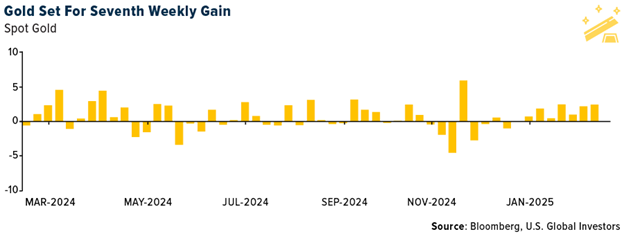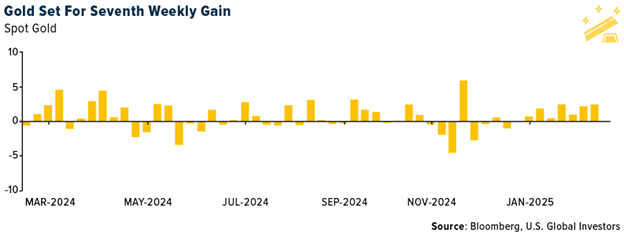Strengths
- The best performing precious metal for the week was palladium, up 1.23%. Gold ETFs experienced outflows, and platinum ETFs declined, indicating a potential shift away from these metals among ETF investors. The limited change in palladium holdings suggests a more resilient investor sentiment toward the metal, however, contributing to its outperformance relative to other precious metals this week, Bloomberg reports.
- Agnico Eagle Mines reported an outstanding 2024 performance, marked by record free cash flow of $2.14 billion and operational cash flow of $3.96 billion. This strong financial performance allowed the company to significantly reduce its net debt by $1.3 billion. The price of gold also moved higher this week, set for its seventh weekly gain, amid uncertainty around trade and the global economy following President Trump’s reciprocal tariffs.

- Evolution Mining reported first-half 2025 underlying EBITDA of $1,014 million, 11% above consensus of $912 million and underlying profit after tax of $385 million, 20% above consensus. Record $385 million group cash flows led the company to declare an interim dividend of 7 cents per share, according to Bank of America. Share price had increased by over 8% by the end of the week.
Weaknesses
- The worst performing precious metal for the week was platinum, down 0.90%. Platinum experienced the worst performance among precious metals this week as exchange-traded funds (ETFs) decreased their platinum holdings, indicating weakening investor sentiment. Further underscoring this weakness, Northam Platinum Ltd warned of a significant slump in first-half earnings due to depressed platinum group metal (PGM) prices.
- President Trump’s threatened tariffs on Europe have created a price disparity between New York and London gold markets, with gold worth substantially more in Manhattan than in London. The logistical challenges of transporting physical gold from London to New York, including recasting bars to meet Comex contract requirements and bottlenecks at the Bank of England’s vaults, are causing delays and increased costs. The price gap is creating difficulties for manufacturers and traders without easy access to physical gold, leading to a surge in gold borrowing rates and potential losses for those unable to quickly obtain gold to cover their positions. This comes as a weakness for gold traders, but a strength for those who bring it online, the gold miners.
- Barrick Gold again met with Mali this past week, but talks were ultimately suspended without reaching an agreement. Mali is holding 3 tons of gold seized from Barrick’s Loulo-Gounkoto mine, forcing Barrick to the negotiating table. However, management is highly reluctant to pay some kind of back tax assessment with the change in government.
Opportunities
- Tatiana Darie, of Bloomberg, noted that gold’s march toward $3,000 per ounce slowed on Friday despite soft spending data and a weaker dollar. However, haven demand amid trade uncertainty is a big driver of gold but central bank buying remains a potent force that will continue to buoy the precious metal, especially from China.
- Beyond just the macro issues,gold buying has been resilient and China’s Financial Supervision Administration has decided to launch a pilot program for insurance funds to invest in gold through a range of channels. Bank of America’s China insurance team estimates a total investment of China insurers of RMB32tn, or $4.4 trillion, so the potential inflows into gold could be RMB180-200bn, or $25-28 billion.
- Simon White, a reporter at Bloomberg, noted that silver’s underperformance relative to gold could shock markets as it plays catch up to gold. Gold has had several explosive rallies in the past but each time the rallies in silver were even more extreme. Investment banks are moving gold bullion from London to New York, and they are also grabbing silver too. This could lead to a shortage of physical metal in London and Europe.
Threats
- Gold’s scorching rally to near $3,000 per ounce threatens to leave buyers in China behind. Bullion’s ascent over the past year has counted Chinese demand among its key drivers. But record prices, a weak economy, and the extra costs imposed by a strong dollar, are making purchases too expensive for many consumers in the world’s biggest buyer, according to Bloomberg.
- BMO notes that New Gold’s updated three-year production guidance featured a 10% decrease for 2025, a 6% increase in 2026, compared to previous guidance, and new 2027 guidance (375-445k ounces). For 2025, production is anticipated to be H225 weighted due to a stripping campaign at Rainy River. New Gold’s share price declined by over 4% by the end of the week.
- As compared to November 2024 targets, Barrick’s revised guidance on average outlines 5% lower gold production, 2% lower copper production, 8% higher AISC, and 2% lower capex, according to RBC.

